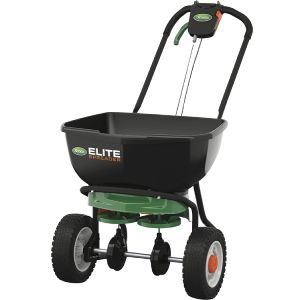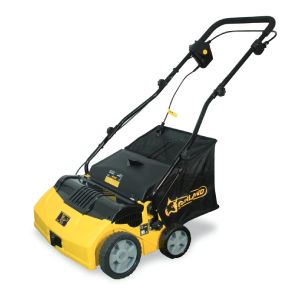- Duralawn
- Artificial Grass Installation
- Artificial Grass Infill
Artificial Grass Infill
Artificial grass infill is important to getting the most out of your new synthetic lawn. The idea of using infill for artificial turf has been standard practice for decades since rubber crumbs and eventually sand, was used for sports fields. In recent years there has been a debate about whether to use no infill, basic silica sand or an acrylic based anti-microbial material but the consensus in Canada and North America is that most synthetic grasses require infill for a proper, long lasting installation.
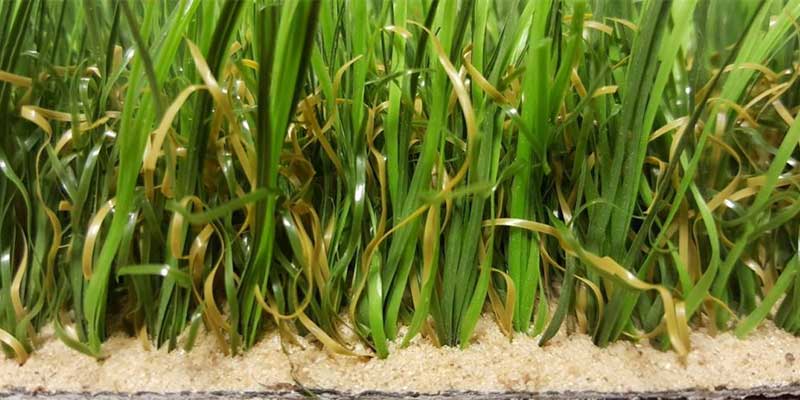
We're going to go over everything you need to know about artificial grass infill including the best kinds, benefits and how to install it properly with an artificial grass power brush for the best and longest lasting results. After reading this page you should have a really good understanding why it's so important to keep your lawn looking great and staying that way for many years.
What is Artificial Grass Infill?
Artificial grass infill is a layer of sand, synthetic materials designed to create a beneficial layer that rests on the turf backing at the base of the synthetic grass blades. Sports fields have been using recycled rubber crumbs for decades for performance and shock absorption. The infill used in artificial grass has numerous benefits as well that we'll discuss below.
Does Artificial Grass need infill?
Yes, artificial grass should have infill whether its kiln-dried silica sand, an acrylic based infill designed to eliminate pet odours, or a combination of both. All the benefits like extending the life of the turf and giving the grass a fuller look far outweigh the only negative which is the increased cost. With an average cost of under a dollar per square foot for artificial grass infill it's well worth it.
Artificial Grass Infill vs no Infill
There are some turf manufacturers and companies claiming that their turf doesn't require infill. Unfortunately this is probably an attempt to gain business by quoting a low cost while sacrificing performance, quality and longevity. Products marketed as non-infill artificial turf are manufactured with a thicker thatch under layer but they still require infill to perform properly.
5 Reasons to Use Artificial Grass Infill
Whether you use a kiln-dried silica sand for artificial grass or an acrylic based organic infill you will be insuring your lawn stays beautiful while protecting your investment for many years. In addition to helping eliminate static shock and preventing weeds from growing in your turf you can count on the following benefits to using infill.
Prevents Rippling
Artificial grass can expand and contract as temperatures fluctuate. The hot summer sun can cause turf to expand several inches and cold temperatures can cause it to contract. This inevitably causes movement of the turf on top of the sub layer that can potentially lead to ripples and ridges if it's not weighed down and fastened properly.
Holds the Turf in Place
The weight of the artificial grass infill is approximately one pound per square foot or five kilograms per square meter. If the infill is spread evenly, the weight is distributed over the entire lawn area and provides the added assurance that the turf won't move or slide over time. This is of greater importance if the turf isn't edged by concrete, a brick pathway or landscape edging.
Keeps Turf Cool
The sun can heat some types of artificial turf up to the point that they are uncomfortable to walk on in bare feet. It can be even more inconvenient for pets that are trying to enjoy the grass during the day. Artificial grass infill acts as a temperature regulator and keeps grass cooler than if you don't use infill.
The backing of most artificial grass is black or dark green and will retain a lot of heat in the summer. Adding a light colored artificial grass infill sand creates a heat reflecting layer that keeps the turf cool by repelling heat.
Protects Fibers and Backing
In addition to keeping the grass fibres standing up straighter and more resistant to wear and tear, infill protects the turf backing. The grass blades are most susceptible to damage at the base of the blade where they tie into the backing. Artificial grass infill that is applied properly will sit along the base of the backing to provide a protective barrier.
While everyday wear like foot traffic, rain and snow should never damage the turf there are instances where the turf is subjected to increased wear. This can be in the form of a dog that likes to dig or the posts of a child's play area.
Improves Drainage
The backing of all quality artificial turf is punched with holes to allow for drainage. The holes allow water to drain through to the sub layer under the turf backing where it's further dissipated out of sight. An adequate infill layer will allow for water, pet urine and rain to drain through at a more regulated rate.
Artificial Grass Infill Materials
The best types of artificial grass infill to use will depend on your unique requirements. A front lawn that gets very limited foot traffic will have different needs than a dog run or child play area. The type of artificial turf you install is also a factor in choosing the best infill because of the varying depths and density.
Silica Sand
Silica sand is the most common turf infill material and the most affordable of all the artificial grass infills. A silica sand that is kiln-dried is the most ideal for optimal performance and to prevent headaches down the road. The term kiln-dried silica sand refers to the process of being subjected to extremely high temperatures to burn off moisture and organics. It's a very fine sand which makes it easy to install properly and resistant to weed growth.
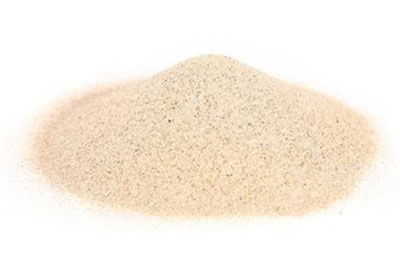
You can buy kiln-dried silica sand for artificial grass at most local hardware stores; Home Hardware and Lowes. It might be available in bulk at a landscaping supply but be sure to stay aware from building or sharp sand that tends to be clumpy and may have organic contaminants.
Acrylic Infill with Anti-Microbials
Many professionals would agree that the best option for artificial grass infill is an acrylic coated infill designed to fight bacteria and odours with its anti-microbial properties. They are ideal for yards with pets especially if the area is a designated dog run or high traffic pet area. Turf that's subjected to ammonia from pet urine can take on an odour when regular sand is used even when it's sprayed down with a garden hose.
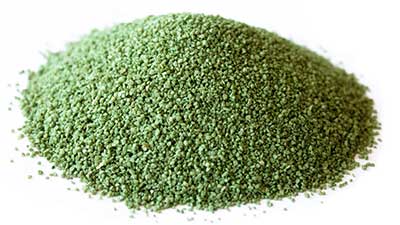
If you are looking for an artificial grass infill for pets, an acrylic anti-microbial product is highly recommended like Envirofill. We also recommend using an enzyme spray cleaner as part of regular turf maintenance. This type of cleaner is sprayed onto the affected area by attaching the concentrated cleaner to a regular garden hose.
How to Install Sand Infill
Installing infill takes 1-2 hours for an average sized lawn and is the final step of the entire artificial grass installation process. If the infill or grass is wet or has any moisture we recommend waiting until it's completely dry before infilling. If it starts to rain, stop and restart when the turf is dry again because it's very difficult to apply infill when it's clumped together.
Calculate How Much Infill is Required
The first step is to determine how much infill sand you need. Calculate the square footage by multiplying the length by the width of the area to be infilled. Our sample lawn is 60 feet long by 20 feet wide, which means we are covering a total area of 1,200 square feet. If your lawn or turf area isn't square, break down the area into smaller sections that are square and add them all together.
60ft x 20ft = 1,200 square feet total area
1,200 square feet = 1,200 pounds of infill sand required
We know from calculating the square footage that we require somewhere in the neighbourhood of 1,200 pounds of infill. This number should be slightly higher if you are installing a turf that has a blade longer than 35mm or a thicker density grass.
Divide Area Into Quadrants
If you break down the area to be infilled into smaller sections it's a lot easier to spread the sand evenly. 4 bags spread over 4 small areas is recommended over spreading 16 bags over 1 large area. The goal is to spread the sand infill as evenly as possible so you don't have any high or low areas.
1,200lbs ÷ 50lb bags = 24 bags of infill sand required
24 bags ÷ 4 quadrants = 6 bags for each quadrant.
If we use the sample above we will require 24 - 50lb bags of sand infill. If we break down the area into 4 equal parts we know that we will be applying 6 bags of sand to each quadrant. It might be practical and easier to break the area down even more or by individual pieces of turf.
Spread Infill
The best way to spread infill over a large areas to use a grass seed spreader or drop spreader. Fill the spreader with sand and work the spreader in a pattern that is conducive to spreading the sand evenly. A criss cross pattern is ideal but might not be practical depending on the shape and size of the area to be infilled. Keep in mind that the more evenly you distributed the sand the easier it is to broom into the turf and better for the final product.
Scott's Elite Broadcast Spreader with Edge Guard 25 LB CapacityIf you click on this link and make a purchase, we may earn a commission. |
Brush Infill into the Turf
The infill needs to be brushed into the roots of the turf and if the infill is still visible you need to brush some more. A gas or electric powered brush is ideal for large areas and a quality push broom will work if the area is small and you have lots of energy. A backpack leaf blower can come in handy for this step and is always good to have around if you plan on doing your own artificial grass maintenance.
The goal is to get all of the sand to sit on the base of the turf out of sight where it will protect the blades and help them stand up. The process of brushing the infill into the turf will fluff up the turf and give it its life-like appearance. If you can see infill you need to keep brushing it into the turf.
Artificial Grass Power Brush Groomer for InfillIf you click on this link and make a purchase, we may earn a commission. |
Artificial Grass Infill FAQ's
We've added a few frequently asked questions that we've been asked by customers. At the end of the day you really should never know infill is there but it is important for the health, appearance and longevity of your lawn.
Will artificial grass infill stick to my feet or my pets feet?
Will artificial grass infill stick to my feet or my pets feet?
No it shouldn't if the infill is brushed into the turf properly you won't even know it's there.
Where can I buy artificial grass infill?
Where can I buy artificial grass infill?
Silica sand can be purchased from your local hardware store. Anti-microbial and organic materials designed for pets can be purchased from a specialty artificial turf grass company.
How much does artificial grass infill cost?
How much does artificial grass infill cost?
Silica sand costs anywhere from $0.25 to $0.75 per pound while more advanced infill products can cost $1.00 per pound or more.
Is there an artificial grass infill made specifically for dog and pet urine?
Is there an artificial grass infill made specifically for dog and pet urine?
Yes. There are advanced infills made specifically for pets that contain odour and bacteria fighting anti-microbials.
Disclaimer
Please use all appropriate and proper safety precautions when attempting projects on this website. All projects are attempted at the reader's own risk.
Duralawn® participates in the Amazon Services LLC Associates Program, as an Amazon Associate we may earn a commission from qualifying purchases.
Duralawn® artificial grass installations, products and service in Kelowna, Vernon, Penticton, etc since 2018.
